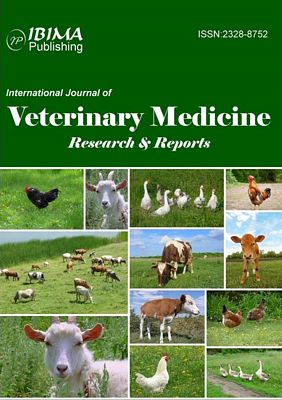Introduction
Trueperella pyogenes (previously, Corynebacterium pyogenes) is an opportunistic pathogen, causing suppurative infections in a wide range of hosts, including avians (Barbour et al., 1991) and domestic animals (Addo et al., 1977). It is known to spread hematogenously to cause abscesses and suppurative lesions in various organs and tissues (Tolle et al., 1983). This organism has been reported to cause liver abscesses in large animals like cattle (Narayananet al., 1998), but its role as an etiological agent for hepatic abscesses in birds like pigeons is yet to be established. The present study reports the isolation and characterization of Trueperella pyogenes from a hepatic abscess in an american fan tailed pigeon.
Materials and Methods
A commercial flock of American-fan tailed pigeons from Thrissur, Kerala was presented with heavy morbidity and mortality. A detailed post-mortem examination of a representative bird, revealed air-sacculitis accompanied by hepatitis and abscesses on the dorsal side of the liver. The tissue and associated material from the hepatic abscess was collected and cultured on- Blood agar, Brain heart infusion (BHI) agar and Mac Conkey agar by incubation at 37°C for 48 hrs under both aerobic and anaerobic conditions. The isolation and characterization by biochemical tests was done by standard tests (Barrow and Feltham, 1993). The antibiotic sensitivity of the isolate to common antibiotics was tested by an antibiogram (Bauer et al., 1966). Further, the pathogenecity of the isolate was successfully demonstrated in Balb/c mice (Kan et al., 2009). The test was carried out with various log dilutions of the basic culture (10-6, 10-7, 10-8 and 10-9) in 0.5 ml saline administered via two routes; intra-venous and sub-cutaneous in mice.
Results
The organisms cultured under anaerobic conditions were observed as rough shaped, creamy colonies on blood agar and BHI agar. The colonies were observed to show β-hemolysis on blood agar. Further, the isolate was identified to be gram-positive pleomorphic non-motile cocco-bacillary organisms. The organisms were characterized to be negative for catalase, oxidase, urease and citrate utilization. These nitrate non-reducing organisms were positive for indole production and were found to be fermenting glucose, lactose, maltose, trehalose, xylose and raffinose but not sucrose, mannitol, salicin, sorbitol, mellibiose and arabinose. The isolated culture was hence identified asTrueperella pyogenes. The isolate was identified to be sensitive for streptomycin and chloramphenicol and resistant to regular antibiotics like amoxicillin, ampicillin, ceftriaxone, gentamicin, tetracycline, sulphadiazine, gatifloxacin, enrofloxacin, ciprofloxacin, tobramycin and polymixin B. Further, the isolate was demonstrated to be highly pathogenic by causing death to mice in by intra-venous administration in a dose-dependant reaction. Death was observed within four hours of administering the highest concentration of 10-6 dilution. The least tested dilution of 10-9of the isolate could cause death within 24 hr of administration. The reaction to the sub-cutaneous administration of the isolate was also observed to be dose-dependant. Abcesses were observed within 24 hours of sub-cutaneous inoculation with 10-6 and 10-7 dilutions of T. pyogenes. The weaker dilutions, 10-8 and 10-9 CFU could cause abscesses within 72 hr of administration.
Discussion
Trueperella pyogenes is a gram positive, pleomorphic and facultative anaerobe reported to cause suupurative and pyogenic infections (Brinton et al., 1993; Reddy et al., 1982). The characterization of the isolate by its cultural, growth and biochemical characteristics confirmed the organism as A. pyogenes. Similar reports for identification were reported by Wust et al., 1993 and Narayanan et al., 1998. The isolate was identified to be resistant to most of the regular antibiotics. The ability of the organisms to cause pyogenic abcesses and their highly pathogenic nature demonstrated in mice, proved them to cause death in the affected birds. The present study presents a highly pathogenic A. pyogenes, which needs to be further characterized to help prevent further economic losses.
References
Addo, P. B. & Dennis, S. M. (1977). “Corynebacteria Associated with Diseases of Cattle, Sheep and Goats in Northern Nigeria,” British Veterinary Journal, 133 (4) 334-339.
Publisher – Google Scholar
Barbour, E. K., Brinton, M. K., Caputa, A., Johnson, J. B. & Poss, P. E. (1991). “Characteristics of Actinomyces Pyogenes Involved in lameness of Male Turkeys in North-Central United States,” Avian Diseases, 35(1) 192-196.
Publisher – Google Scholar
Barrow, G. I. & Feltham, R. K. A. (1993). Cowan and Steel’s Manual for the Identification of Medical Bacteria,Cambridge University Press, Australia.
Publisher – Google Scholar
Bauer, A. W., Kirby, W. M. M., Sherris, J. C. & Turck, M. (1966). ‘Antibiotic Susceptibility Testing by a Standardized Single Disc Method,’ American Journal of Clinical Pathology, 45(4) 493-496.
Google Scholar
Brinton, M. K., Schellberg, L. C., Johnson, J. B., Frank, R. K., Halvorson, D. A. & Newman, J. A. (1993). “Description of Osteomyelitis Lesions Associated with Actinomyces Pyogenes Infection in the Proximal Tibia of Adult Male Turkeys,”Avian Diseases, 37(1) 259-262.
Publisher – Google Scholar – British Library Direct
Kan, I. Y., Blum, S. & Elad, D. (2009). ‘Synergism between Porphyromonas Levii and Trueperella Pyogenes in a Murine Abscess Model,’ Israel Journal of Veterinary Medicine, 64(3) 1-7.
Narayanan, S., Nagaraja, T. G., Wallace, N., Staats, J., Chengappa, M. M. & Oberst, R. D. (1998). “Biochemical and Ribotypic Comparison of Actinomyces Pyogenes and Actinomyces Pyogenes-Like Organisms from Liver Abscesses, Ruminal Wall, and Ruminal Contents of Cattle,” American Journal of Veterinary Research, 59(4) 271-276.
Publisher
Reddy, C. A., Cornell, C. P. & Fraga, A. M. (1982). “Transfer of Corynebacterium Pyogenes (Glage) Eberson to the Genus Actinomyces as Actinomyces Pyogenes (Glage) Comb. Nov.,” International Journal of Systemic Bacteriology, 32(4) 419-429.
Publisher – Google Scholar
Tolle, A., Franke, V. & Reichmuth, J. (1983). “Corynebacterium Pyogenes Mastitis – Bacteriological Aspects,” Deutsche tierärztliche Wochenschrift, 90(7) 256-260.
Publisher
Wust, J., Lucchini, G. M., Luthy-Hottenstein, J., Brun, F. & Altwegg, M. (1993). “Isolation of Gram-Positive Rods that Resemble but are Clearly Distinct from Actinomyces Pyogenes from Mixed Wound Infections,” Journal of Clinical Microbiology, 31(5) 1127-1135.
Publisher – Google Scholar – British Library Direct



